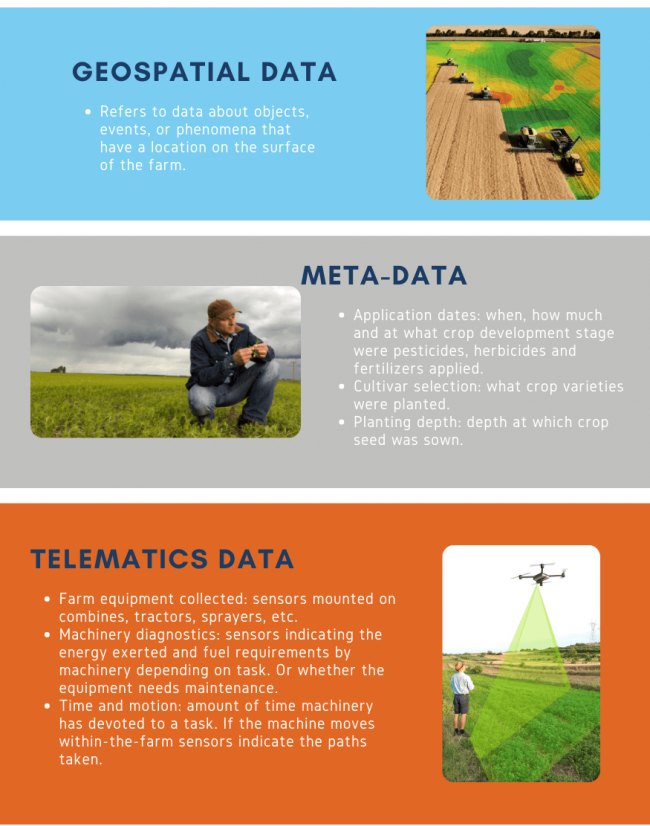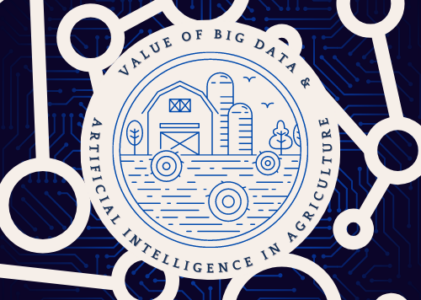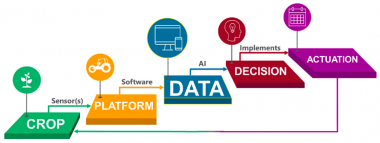
To tackle pressures from the world’s fast-growing population, increasing food demands, and the changing climates, there are several anticipated ways to enhance agricultural productivity and food security. These include reducing food loss and waste, adopting improved crops, and integrating advanced technologies on-farm and in food systems. The use of improved plant varieties from new breeding techniques (NBTs) and genome editing (GE) has been highlighted in previous published work and blogs (like on GE and NBTs). This blog discusses the role of big data technology in agriculture by reporting key results of an online expert survey conducted in spring/summer 2019.
Big data transforms agriculture from traditional to digital
![]() Advanced technologies such as GPS (Global Positioning System) guidance, drones, satellite mapping, remote sensors, and precision machinery transition agriculture into the digital economy (precision agriculture). The integration of these technologies in farming practices and within the equipment, generates large amounts of data, or big data, during the production process. For farmers, such enhanced data can be an asset, but also provide such high volumes of raw data, that it is not helpful. However, as data science and data interfaces evolve, we see how agriculture has become data-driven. Raw data becomes a fourth production factor along with land, labour, and capital. Big data technology facilitates making better farm-level decisions in terms of production, procurement, human and financial management, etc. For example, real-time data providing information on soil characteristics or climatic conditions (see Figure 1 for a list of big data types in agriculture) help farmers make real-time decisions and act efficiently. This process is displayed in Figure 2.
Advanced technologies such as GPS (Global Positioning System) guidance, drones, satellite mapping, remote sensors, and precision machinery transition agriculture into the digital economy (precision agriculture). The integration of these technologies in farming practices and within the equipment, generates large amounts of data, or big data, during the production process. For farmers, such enhanced data can be an asset, but also provide such high volumes of raw data, that it is not helpful. However, as data science and data interfaces evolve, we see how agriculture has become data-driven. Raw data becomes a fourth production factor along with land, labour, and capital. Big data technology facilitates making better farm-level decisions in terms of production, procurement, human and financial management, etc. For example, real-time data providing information on soil characteristics or climatic conditions (see Figure 1 for a list of big data types in agriculture) help farmers make real-time decisions and act efficiently. This process is displayed in Figure 2.
Figure 1: Types of big data in agriculture

Figure 2: Data-based decision-making for advanced agriculture
A survey of 81 international experts in plant breeding identified the importance of different enabling analytics for data-driven agriculture (Table 1). Ranked among the top cross-cutting technologies were software-based decision support systems (that gather and analyze data to address system dynamics and optimization issues), sensors (that collect information on the functioning of equipment and farm resources), and digital communications tools. Field-based technologies such as geographic information and geo-locating systems that collect real-time data are also identified as vital to the future of the agricultural sector. In some instances, some of these technologies have a lengthy use record, illustrating they are now an integral part of modern agriculture, while some of the newer technologies with shorter use periods are lower ranked, such as with drones.
Table 1. Expert opinion on the enabling analytics for data-driven agriculture

Artificial intelligence complements big data
Raw data requires analysis for it to have value. Analytics involving artificial intelligence (AI) is required for data mining. AI is a relatively new technical discipline adopted by agricultural research and corporations that assesses the expansion of human intelligence by developing theories, methods, algorithms, and applications. Given the size and complexity of big data which cannot be handled by traditional data-processing systems, AI through machine learning algorithms is designed to extract meaningful value from big data.
In agriculture, AI is primarily being applied to increase productivity and efficiency. Of the AI applications being developed in agriculture are yield prediction algorithms using weather and historical yield data, image recognition algorithms for pest and disease detection in plants, and robotics for crop harvesting [2]. For instance, autonomous AI robots can harvest produce at a higher capacity and faster rate compared to human labour.
While AI applications are emerging in agriculture, our surveyed experts anticipate that deployment of AI offers moderate (35%), large (33%), or substantial (23%) contributions to the overall industry. Respondents agree that AI will contribute positively to agricultural machinery and logistics, each at 90%, market information at 89%, plant breeding at 81%, and risk management at 71% [1].
Looking forward
Experts believe that the deployment of digital decision-support tools, big data analytics, and artificial intelligence can improve agricultural productivity in several ways including climate forecast, yield prediction, crop selection, and diseases/pest management. However, the benefits of big data technologies are likely to be captured, for a while, by developed nations who are able to make substantial upfront investments. Based on expert views, big data and AI will play a leading role in improving global food security by helping to reduce losses and increasing yields.
- Lassoued R, Macall DM, Smyth SJ, Phillips PWB, and Hesseln H. Expert Insights on the Impacts of, and Potential for, Agricultural Big Data. Sustainability, 2021. 13(5): p. 2521.
- Al-Turjman F. The Cloud in IoT-enabled Spaces, ed. K.E. 1st Edition. 2019, Boca Raton London NY: CRC Press. 312.
If you would like to know more about Dr. Lassoued’s research related to this posting you can find them on the publications page of the multi-year project Regulation of New Breeding Techniques webpage.



